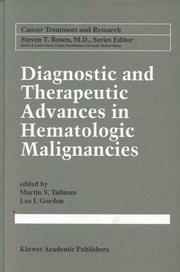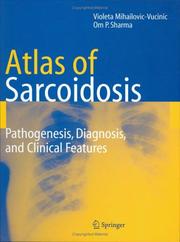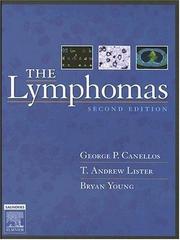| Listing 1 - 10 of 15 | << page >> |
Sort by
|
Book
Year: 2015 Publisher: Bruxelles: UCL. Faculté de médecine et de médecine dentaire,
Abstract | Keywords | Export | Availability | Bookmark
 Loading...
Loading...Choose an application
- Reference Manager
- EndNote
- RefWorks (Direct export to RefWorks)
Le Syndrome lymphoprolifératif Post-Transplantation {PTLD) est caractérisé par une prolifération lymphocytaire après greffe, pouvant évoluer en un lymphome de type B,éventuellement de typeT (1,2). Durant la première année post-transplantation,l'incidence de cette complication s'est élevée à 8,7% chez les enfants greffés du foie entre 2010 et 2014 aux Cliniques Universitaires Sa intLuc (CuSL). Les principaux facteurs de risque de PTLD sont un jeune âge lors de la greffe, un haut degré d'immunosuppression et un statut sérologique négatif pour l'EBV en période préopératoire, principalement lorsque le donneur hépatique est EBV-positif. De plus, étant donné que la plupart des patients sont infectés par l'EBV au cours des 3 premiers mois suivant la greffe, la première année posttransplantation est considérée comme un période à haut risque (1, 4). L'introduction du Basiliximab(Simulect®) dans le schéma immunosuppresseur ne semble quant à lui pas influencer l'incidence decette complication (13).D'un point de vue thérapeutique, la réduction de l'immunosuppression constitue la pierre angulaire de la prise en charge du PTLD (1,2,4). Par conséquent, le risque de présenter un épisode de rejet voire de perdre le greffon n'est pas négligeable chez ces patients (1). Dans ce contexte,il semble important d'identifier au plus tôt les patients à risque de PTLD dans le but de diminuer la fréquence et la sévérité de cette affection. Le monitoring par PCR de la charge virale en EBV est actuellement la méthode la plus aisée afin de reconnaître les enfants susceptibles de développer cette complication. Cependant, dans notre série, une charge virale élevée en EBV (> 25.000 copies/µg d'ADN) présente une valeur prédictive positive limitée (18,2%) quant à l'évaluation de ce risque.Par ailleurs, le rôle des lymphocytes NK dans le contrôle de la primo-infection à EBV est de plus en plus reconnu (1,8). L'analyse phénotypique en cytométrie de flux des cellules NK pourrait dès lors devenir un outil intéressant dans le suivi des patients transplantés du foie. En effet, nous avons identifié au sein de cette étude une augmentation de la proportion des NK totaux (CD3-CD56±) et des NK CD56+CD16+ ainsi qu'une réduction des NK CD56++ chez les patients atteints d'un PTLD.De plus,un test associant un taux de CD3-CD56± 12,5% et de CD56+CD16+ 63% montrerait des valeurs prédictives positives et négatives de 100%.En définitive, les résultats présentés dans cette étude rappellent, d'une part, l'importance de cette complication chez les enfants ayant bénéficié d'une greffe hépatique. D'autre part, ils mettent en évidence l'intérêt potentiel du monitoring des lymphocytes NK en cytométrie de flux afin d'identifier précocement les patients à risque de PTLD. Post-transplantation lymphoproliferative diseases (PTLD) are characterized by a lymphoproliferation after transplantation, which can evolve into a type B or possibly a type T lymphoma (1,2). During the first year post-transplant, the incidence of this complication was 8.7% for children who have been grafted between 2010 and 2014 in the Cliniques Univers itaires Saint-Luc (CuSL). The main risk factors for PTLD are a young age at transplant, a high degree of immunosuppression and a negative status for EBV before the operation, especially when the liver donor is EBV-positive. ln addition, the first year after transplantation is considered to be a high-risk period because most patients are infected with EBV in the first 3 months post-transplant, (1, 4). However, the introduction of Basiliximab (Simulect®) in the immunosuppressive regimen does not appear to influence the incidence of this complication (13).From a therapeutic point of view, the main treatment of PTLD is the reduction of immunosuppression (1,2,4). Therefore, the risk of reject ion or graft loss is not insignificant (1). ln this context, it seems important to identify early patients at risk of PTLD to decrease the frequency and the severity of this condition. The monitoring of EBV viral load by PCR is currently the easiest method to identify children at risk of PTLD. However, in our population, a high viral load (> 25,000 copies/ug DNA) has a limited positive predictive value (18,2%).On the other hand, the role of NK cells in the control of primary EBV infection is increasingly recognized (1, 8). Therefore, phenotypic analysis by flow cytometry could be a useful tool to monitoring these patients. lndeed, among patients with PTLD, we identified an increased proportion of total NK cells (Co3·co56±) and CD56+co16+ NK cells and a reduced proportion of CD56++ NK cells. ln addition, a test based on a rate of CD3-CD56± cells 12.5% and a rate of CD56+CD16+ cells 63% offers a positive and a negative predictive value of 100%.ln conclusion, PTLD remains an important complication for children who received a liver transplant. However, flow cytometry could be an effective tool to identify as soon as possible patients at risk of PTLD.
Book
ISSN: 21514208 ISBN: 1617051497 9781617051494 1936287773 9781936287772 9781936287772 Year: 2012 Volume: v. 3, issue 3 Publisher: New York Demos Medical Pub.
Abstract | Keywords | Export | Availability | Bookmark
 Loading...
Loading...Choose an application
- Reference Manager
- EndNote
- RefWorks (Direct export to RefWorks)
Authoritative reviews and updates discuss recent advances in radiation therapy in treatment of Hodgkins lymphoma, B-cell nodal and extranodal lymphomas, follicular lymphoma and cutaneous T-cell lymphoma; mantle cell lymphoma, and leukemia. In addition, reviews of current developments in PET imaging in lymphoma, radioimmunotherapy, and radiation and transplant, are included. This volume of Radiation Medicine Rounds gives the radiation oncology professional a complete overview of current best practice and emerging modalities for radiation treatment of hematologic malignancies.Hematologic Maligna
Lymphoproliferative disorders. --- Immunoproliferative disorders --- Lymphoproliferative syndrome --- Cell proliferation --- Immunological deficiency syndromes --- Lymphatics --- Lymphomas --- Diseases
Book
ISBN: 1617052701 9781617052705 9781620700945 1620700948 9780826149770 0826149774 Year: 2017 Publisher: New York
Abstract | Keywords | Export | Availability | Bookmark
 Loading...
Loading...Choose an application
- Reference Manager
- EndNote
- RefWorks (Direct export to RefWorks)
Lymphoproliferative disorders --- Immunoproliferative disorders --- Lymphoproliferative syndrome --- Cell proliferation --- Immunological deficiency syndromes --- Lymphatics --- Lymphomas --- Diseases
Book
ISBN: 1789239427 1789239419 Year: 2019 Publisher: London, England : IntechOpen,
Abstract | Keywords | Export | Availability | Bookmark
 Loading...
Loading...Choose an application
- Reference Manager
- EndNote
- RefWorks (Direct export to RefWorks)
Lymphoproliferative disorders. --- Blood --- Diseases. --- Clinical hematology --- Hematologic diseases --- Hematology --- Immunoproliferative disorders --- Lymphoproliferative syndrome --- Cell proliferation --- Immunological deficiency syndromes --- Lymphatics --- Lymphomas --- Diseases

ISBN: 0585385718 0792382064 Year: 1999 Publisher: Boston ; Dordrecht ; London : Kluwer Academic Publishers,
Abstract | Keywords | Export | Availability | Bookmark
 Loading...
Loading...Choose an application
- Reference Manager
- EndNote
- RefWorks (Direct export to RefWorks)
Lymphoproliferative disorders. --- Lymphoproliferative disorders --- Molecular aspects. --- Oncology . --- Internal medicine. --- Hematology. --- Oncology. --- Internal Medicine. --- Haematology --- Internal medicine --- Blood --- Medicine, Internal --- Medicine --- Tumors --- Diseases --- Hematologic Neoplasms --- Diagnosis. --- Immunoproliferative disorders --- Lymphoproliferative syndrome --- Cell proliferation --- Immunological deficiency syndromes --- Lymphatics --- Lymphomas
Book
ISSN: 12951404 ISBN: 9782742007363 9782742010684 2742010688 2742007369 Year: 2009 Publisher: Montrouge [France]
Abstract | Keywords | Export | Availability | Bookmark
 Loading...
Loading...Choose an application
- Reference Manager
- EndNote
- RefWorks (Direct export to RefWorks)
Leukemia, Lymphoid --- Chronic Disease --- Waldenström Macroglobulimenia --- Lymphocytic leukemia. --- Lymphoproliferative disorders. --- Immunoproliferative disorders --- Lymphoproliferative syndrome --- Cell proliferation --- Immunological deficiency syndromes --- Lymphatics --- Lymphomas --- Leukemia, Lymphocytic --- Lymphatic leukemia --- Lymphoid leukemia --- Leukemia --- Lymphoproliferative disorders --- Diseases
Book
ISBN: 146983099X 1469879913 9781469879918 9781469830995 9781609136826 1609136829 Year: 2014 Publisher: Philadelphia : Wolters Kluwer Health / Lippincott Williams & Wilkins,
Abstract | Keywords | Export | Availability | Bookmark
 Loading...
Loading...Choose an application
- Reference Manager
- EndNote
- RefWorks (Direct export to RefWorks)
The Third Edition of Knowles Neoplastic Hematopathology has been thoroughly updated by the world's experts to cover all aspects of neoplastic hematopathology, a field that covers disorders of the bone marrow, spleen, and lymphatic system. Now in full-color, this completely revised and expanded edition integrates the basic science, modern diagnostic techniques, and clinical aspects of malignant diseases affecting these organs. It is the most comprehensive, encyclopedic textbook concerning neoplastic hematopathology available on the market today.
Lymphoproliferative disorders --- Hematopoietic system --- Hematopoietic system. --- Bone marrow --- Hemopoietic system --- Hematopoiesis --- Immunoproliferative disorders --- Lymphoproliferative syndrome --- Cell proliferation --- Immunological deficiency syndromes --- Lymphatics --- Lymphomas --- Cytopathology. --- Cancer --- Diseases. --- Diseases --- Hematopoietic System --- Bone Marrow Diseases --- Hematologic Neoplasms --- Leukemia --- Lymphoproliferative Disorders --- pathology
Book
ISBN: 9783319192949 3319192930 9783319192932 3319192949 Year: 2015 Publisher: Cham : Springer International Publishing : Imprint: Humana,
Abstract | Keywords | Export | Availability | Bookmark
 Loading...
Loading...Choose an application
- Reference Manager
- EndNote
- RefWorks (Direct export to RefWorks)
The second edition of this text presents an overview of the most recent developments in this area including clinical presentation, etiology, pathogenesis, and differential diagnosis. The rationale for various therapies, including transplantation, is discussed and tissue diagnosis (its pitfalls and strategies for avoiding them) and laboratory support are included. The involvement of all major organ systems including renal/genitourinary, cardiac, gastrointestinal, pulmonary, peripheral nerve/central nervous system, soft tissue, skin, lymph node/spleen and bone marrow pathology is also covered. Amyloid and Related Disorders, Second Edition will be invaluable to specialized and general pathologists as well as cytopathologists. Other medical professionals may also benefit from this concise update on the systemic amyloidoses.
Medicine & Public Health. --- Pathology. --- Nephrology. --- Oncology. --- Medicine. --- Médecine --- Néphrologie --- Cancérologie --- Pathologie --- Amyloidosis. --- Lymphoproliferative disorders. --- Pathology --- Medicine --- Health & Biological Sciences --- Immunoproliferative disorders --- Lymphoproliferative syndrome --- Amyloid degeneration --- Cell proliferation --- Immunological deficiency syndromes --- Lymphatics --- Lymphomas --- Lymphoproliferative disorders --- Proteins --- Diseases --- Metabolism --- Disorders --- Oncology . --- Tumors --- Internal medicine --- Kidneys --- Disease (Pathology) --- Medical sciences --- Medicine, Preventive

ISBN: 1280460172 9786610460175 1846280931 1852338091 1849969256 Year: 2005 Publisher: London : Springer,
Abstract | Keywords | Export | Availability | Bookmark
 Loading...
Loading...Choose an application
- Reference Manager
- EndNote
- RefWorks (Direct export to RefWorks)
Sarcoidosis is a complex multisystem disease. Shortness of breath (dyspnea) and a cough that won't go away can be among the first symptoms of sarcoidosis, but sarcoidosis can also show up suddenly with the appearance of skin rashes and other dermatoses. An Atlas of Sarcoidosis: Pathogenesis, Diagnosis and Clinical Features combines illustrations and clinical images of the authors' extensive practices, so that readers have unparalleled access to a comprehensive collection of sarcoidosis images. The atlas is designed to complement and provide a visual supplement to already existing texts on sarcoidosis. Each organ involvement is dealt in a brief and easy to comprehend manner. Various radiographic and laboratory abnormalities are then linked to the clinical features in order to encourage a smooth and easy practical integration at the bedside and to help practising pulmonologists, dermatologists and other clinicians who require a comprehensive visual encyclopedia of sarcoidosis images.
Sarcoidosis --- Lymphoproliferative disorders. --- Immunoproliferative disorders --- Lymphoproliferative syndrome --- Cell proliferation --- Immunological deficiency syndromes --- Lymphatics --- Lymphomas --- Besnier-Boeck disease --- Boeck's sarcoid --- Granuloma benignum --- Lymphogranulomatosis benigna --- Schaumann's disease --- Lymphoproliferative disorders --- Pseudotuberculosis --- Tumors --- Diseases --- Dermatology. --- Immunology. --- Radiology, Medical. --- Pneumology. --- Imaging / Radiology. --- Diagnostic Radiology. --- Pneumology/Respiratory System. --- Clinical radiology --- Radiology, Medical --- Radiology (Medicine) --- Medical physics --- Immunobiology --- Life sciences --- Serology --- Medicine --- Skin --- Radiology. --- Respiratory organs—Diseases. --- Radiological physics --- Physics --- Radiation --- Respiratory organs --- Diseases. --- Respiratory diseases

ISBN: 0721600816 9780721600819 Year: 2006 Publisher: Philadelphia W.B. Saunders
Abstract | Keywords | Export | Availability | Bookmark
 Loading...
Loading...Choose an application
- Reference Manager
- EndNote
- RefWorks (Direct export to RefWorks)
Lymphoproliferative Disorders --- Neoplasms by Histologic Type --- Lymphatic Diseases --- Neoplasms --- Immunoproliferative Disorders --- Diseases --- Hemic and Lymphatic Diseases --- Immune System Diseases --- Lymphoma --- Disorder, Immunoproliferative --- Disorders, Immunoproliferative --- Immunoproliferative Disorder --- Benign Neoplasms --- Malignancy --- Malignant Neoplasms --- Neoplasia --- Neoplasm --- Neoplasms, Benign --- Cancer --- Tumors --- Benign Neoplasm --- Cancers --- Malignancies --- Malignant Neoplasm --- Neoplasias --- Neoplasm, Benign --- Neoplasm, Malignant --- Neoplasms, Malignant --- Tumor --- Medical Oncology --- Lymphatism --- Status Lymphaticus --- Disease, Lymphatic --- Diseases, Lymphatic --- Lymphatic Disease --- Histological Type of Neoplasm --- Histological Types of Neoplasms --- Neoplasms by Histological Type --- Neoplasm Histological Type --- Neoplasm Histological Types --- Neoplasms Histological Type --- Neoplasms Histological Types --- Duncan Disease --- Epstein-Barr Virus Infection, Familial Fatal --- Epstein-Barr Virus-Induced Lymphoproliferative Disease In Males --- Familial Fatal Epstein-Barr Infection --- Immunodeficiency 5 --- Immunodeficiency, X-Linked Progressive Combined Variable --- Lymphoproliferative Disease, X-Linked --- Lymphoproliferative Syndrome, X-Linked, 1 --- Purtilo Syndrome --- X-Linked Lymphoproliferative Disease --- X-Linked Lymphoproliferative Disorder --- Duncan's Syndrome --- X-Linked Lymphoproliferative Syndrome --- Disease, Duncan --- Disease, X-Linked Lymphoproliferative --- Diseases, X-Linked Lymphoproliferative --- Disorder, Lymphoproliferative --- Disorder, X-Linked Lymphoproliferative --- Disorders, Lymphoproliferative --- Disorders, X-Linked Lymphoproliferative --- Epstein Barr Virus Induced Lymphoproliferative Disease In Males --- Epstein Barr Virus Infection, Familial Fatal --- Familial Fatal Epstein Barr Infection --- Immunodeficiency 5s --- Immunodeficiency, X Linked Progressive Combined Variable --- Lymphoproliferative Disease, X Linked --- Lymphoproliferative Diseases, X-Linked --- Lymphoproliferative Disorder --- Lymphoproliferative Disorder, X-Linked --- Lymphoproliferative Disorders, X-Linked --- Lymphoproliferative Syndrome, X-Linked --- Lymphoproliferative Syndromes, X-Linked --- Purtilo Syndromes --- Syndrome, Purtilo --- Syndrome, X-Linked Lymphoproliferative --- Syndromes, Purtilo --- Syndromes, X-Linked Lymphoproliferative --- X Linked Lymphoproliferative Disease --- X Linked Lymphoproliferative Disorder --- X Linked Lymphoproliferative Syndrome --- X-Linked Lymphoproliferative Diseases --- X-Linked Lymphoproliferative Disorders --- X-Linked Lymphoproliferative Syndromes --- Amyloidosis --- Germinoblastoma --- Lymphoma, Malignant --- Reticulolymphosarcoma --- Sarcoma, Germinoblastic --- Germinoblastic Sarcoma --- Germinoblastic Sarcomas --- Germinoblastomas --- Lymphomas --- Lymphomas, Malignant --- Malignant Lymphoma --- Malignant Lymphomas --- Reticulolymphosarcomas --- Sarcomas, Germinoblastic --- Hematologic Neoplasms --- Diseases of Immune System --- Immune Diseases --- Immunological Diseases --- Immune Disorders --- Immune System Disorders --- Immunologic Diseases --- Disease, Immune --- Disease, Immune System --- Disease, Immunologic --- Disease, Immunological --- Disorder, Immune System --- Immune Disease --- Immune Disorder --- Immune System Disease --- Immune System Disorder --- Immunologic Disease --- Immunological Disease --- Blood and Lymphatic System Disorders
| Listing 1 - 10 of 15 | << page >> |
Sort by
|

 Search
Search Feedback
Feedback About UniCat
About UniCat  Help
Help News
News